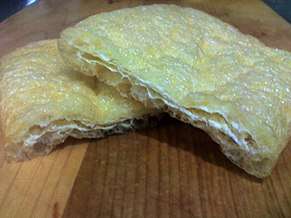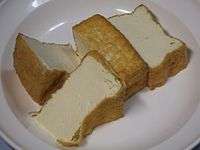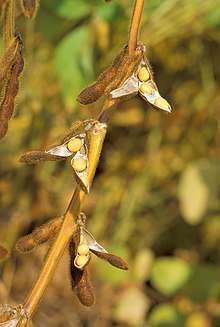Abura-age
Abura-age (油揚げ), is a Japanese food product made from soybeans. It is produced by cutting tofu into thin slices and deep-frying them first at 110–120 °C, and then again at 180–200 °C. Abura-age is often used to wrap inari-zushi (稲荷寿司), and is added to miso soup. It is also added to udon noodle dishes, which are called kitsune-udon because of legends that foxes (kitsune) like deep-fried tofu. Abura-age can also be stuffed, e.g. with nattō, before frying again. There is a thicker variety known as atsu-age (厚揚げ) or nama-age (生揚げ).


The Japanese were the first to develop tofu pouches. However, little is known of their early history. The Tofu Hyakuchin of 1782 (Abe 1972) gave a recipe for deep-fried tofu, but it is not clear if it puffed up like a tofu pouch. It is known that tofu pouches existed by 1853, when inari-zushi (tofu pouches filled with vinegared rice) originated (Ichiyama 1968). Because of their long storage life, light weight, and complexity of production, tofu pouches lend themselves to large-scale factory production and widespread distribution. By 1974 large factories were using two metric tons of soybeans a day to make 116,600 tofu pouches. By 1980 huge modern factories produced 300,000 to 450,000 pouches a day using conveyorized deep fryers. At this time roughly a third of the soybeans consumed for tofu in Japan were for deep-fried tofu, and an estimated 85 percent of this was for tofu pouches.
In Japanese mythology abura-age is the favorite food of Kitsune and Inari.
See also
- Tempura – Japanese dish of battered deep-fried fish or vegetables
- List of deep-fried foods – Wikipedia list article
- List of soy-based foods – Wikipedia list article

References
| Wikimedia Commons has media related to Aburaage. |
- Kenkyusha's New Japanese-English Dictionary, Kenkyusha Limited, Tokyo 1991, ISBN 4-7674-2015-6
